INTRODUCTION
SEX/GENDER ISSUE FROM THE PERSPECTIVE OF PATIENTS
Table 1.
| Study | Study population (total n, M n, F n) |
Outcomes |
|||
|---|---|---|---|---|---|
| Patient gender | Reasons for preference | Other preferences studied | Care delays | ||
| Fidler et al. 2000, United Kingdom5 | 101 | % Of FP expressing preference=50.7% | Not studied | Age | 34% Of FP willing to wait to have a F colonoscopist |
| M (34), F (65), U (2) | 93.9% For F endoscopist | ||||
| 6.1% For M endoscopist | |||||
| % of MP expressing preference for=5.9% | |||||
| 100% For F endoscopist | |||||
| 0% For M endoscopist; p<0.001 | |||||
| Varadarajulu et al. 2002, United States4 | 150 | % Of FP expressing gender preference=45% | Not studied | Age | Patients with expressed gender preference willing to wait >1 mo |
| Tertiary healthcare center and affiliate hospitals | M (70), F (80) | 94.4% For F endoscopist | Ethnic origin | 90% Of FP | |
| 5.6% For M endoscopist | 66% Of MP | ||||
| % Of MP expressing gender preference=4.3% | |||||
| 34.9% For F endoscopist | |||||
| 65.1% For M endoscopist; p<0.001 | |||||
| Farraye et al. 2004, United States3 | 541 | % Of patients expressing a gender preference=46.2% | Fear: | Not studied | Not studied |
| Large multispecialty urban healthcare group | M (241), F (300) | 67.2% FP | More FP reporting being frightened compared with MP (p<0.001) | ||
| 32.8% MP | |||||
| % Of FP expressing same-sex preference=56.0% | Embarrassment: | ||||
| More FP reporting being embarrassed compared with MP (p <0.001) | |||||
| % Of MP expressing same-sex preference=34.0%; p<0.001 | General health: | ||||
| Less FP reporting CRC screening was important than MP (p=0.006) | |||||
| Convenience: | |||||
| More FP reported inconvenience with having CRC screening than MP=0.03 | |||||
| Menees et al. 2005, United States11 | 202 | % Of FP expressing gender preference=44.4% | Reasons for preferring F endoscopists: | Gender of patient’s primary care practitioner | Patients with expressed gender preference willing to wait >30 days: |
| Four outpatient primary care clinics associated with academic health system | F (202) | 96.8% For F endoscopist | Less embarrassment with F endoscopists (75%) | Employment status | 87% FP with same-sex preference |
| 3.2% For M endoscopist | F endoscopists are more empathetic (50%) | 100% FP with opposite-sex preference | |||
| F endoscopists are better listener (36%) | |||||
| F endoscopists are technically better (20%) | |||||
| Lee et al. 2008, Korea12 | 465 | Of FP expressing preference for colonoscopist=45.5% | Not studied | Age | Not studied |
| Single digestive disease center in university hospital | F (465) | 70.5% For F endoscopist | Education | ||
| 29.5% For M endoscopist | Employment Dysmenorrhea | ||||
| % Of FP expressing; preference for EGD=32.7% | |||||
| 49.5% For F endoscopist | Gender of physician during encounter | ||||
| 50.5% For M endoscopist | Gender of previous colonoscopist | ||||
| Medical historya) | |||||
| Schneider et al. 2009, United States7 | 500 | % Of FP expressing gender preference=42.7% | Reasons for FP preferring; F endoscopists | Income level | Not studied |
| Outpatient endoscopy in inner city tertiary academic hospital | M (214), F (286) | 91.8% For F endoscopist | F endoscopists are easier to talk to (27%) | History of abuse | |
| 8.2% For M endoscopist | Less embarrassed with F endoscopists (26%) | Education level | |||
| % Of MP expressing gender preference=for 21% | F endoscopists are more caring (21%) | ||||
| 32.4% For F endoscopist | Reasons for MP preferring M endoscopists | ||||
| 67.6% For M endoscopist | M endoscopists are easier to talk to (38%) | ||||
| p<0.001 (OR, 2.46; 95% CI, 1.56–3.87) | Less embarrassment with M endoscopists (30%) | ||||
| M endoscopists are more accurate and thorough (15%) | |||||
| Reason for MP preferring; F endoscopists | |||||
| F endoscopists are easier to talk to (46%) | |||||
| Zapatier et al. 2011, United States9 | 438 | % Of all patients expressing a gender preference=25.7% | Reasons for preferring F endoscopist: | Education level | Women more likely than men to delay their colonoscopies to ensure an endoscopist of their preferred gender (p=0.35) |
| Outpatient primary care clinic | M (213), F (225) | % Of all Hispanic patients expressing a gender preference=24.1% | Less embarrassment with F endoscopists (31%) | Being first-generation immigrant | |
| F endoscopists are easier to talk to (13%) | Family history of CRC | ||||
| % Of FP expressing gender preference=30.8% | |||||
| 84.8% For F endoscopist | F endoscopists care more (8%) | Ethnicity preference for endoscopists | |||
| % Of Hispanic FP expressing a gender preference=35% | F endoscopists are more accurate/thorough (2%) | ||||
| % Of MP expressing gender preference=20.4% | F endoscopists are gentler (12%) | ||||
| p=0.05 | Reasons for preferring M endoscopist: | ||||
| Less embarrassment with M endoscopists (38%) | |||||
| M endoscopists are easier to talk to (15%) | |||||
| M endoscopists are more accurate/thorough (10%) | |||||
| M endoscopists are smarter (4%) | |||||
| M endoscopists are gentler (4%) | |||||
| Shah et al. 2011, United States8 | 1364 | Overall % of FP expressing gender preference=53% | Reasons for preference of endoscopist gender: | Education level | Patients with expressed same-sex gender preference willing to delay care: |
| Veterans Affairs and community hospital | M (777), F (587) | 92.5% for F endoscopist | Embarrassment (FP, 79.9%; MP, 64.6%; p<0.001) | 34.1% FP | |
| 7.5% for M endoscopist | More compassionate | 20.5% MP; p<0.001 | |||
| Overall % of MP expressing gender preference for=27.8%; 15.8% for F endoscopist; 84.2% for M endoscopist; p=0.001 | Better listener | ||||
| More technically skilled | |||||
| Chong, 2012, Brunei13 | 470 | % Of FP expressing preference=70% | Not studied | Education level | Willingness to undergo screening colonoscopy despite preferences not being met: |
| Referral center | M (207), F (263) | 96.7% for F endoscopist | Marital status | Male vs. female: OR, 1.68; 95% CI, 1.00–2.82; p=0.049 | |
| 3.3% for M endoscopist | Employment status | ||||
| % Of MP expressing preference for=62.8% | Family history of cancer (including CRC) | ||||
| 10.8% for F endoscopist | |||||
| 89.2% for M endoscopist | |||||
| p=0.102 | |||||
| Lahat et al. 2013, Israel14 | 946 | % Of FP expressing preference=36% | More trust in the endoscopist (only in FP who preferred M endoscopists) | Age | Not studied |
| Tertiary referral center | M (558), F (388) | 74% for F endoscopist | Education | ||
| 26% for M endoscopist | Non-Jewish faith | ||||
| % Of MP expressing preference for=27% | Non-Western background | ||||
| 11.1% for F endoscopist | Orthodox religious practice | ||||
| 88.8% for M endoscopist; OR, 1.50; 95% CI, 1.14–1.98 | Type of procedure; previous endoscopy | ||||
| Varia et al. 2014, United States10 | 200 | % Of FP expressing gender preference=38% | Not studied | Gender preference for the primary care physician | Not studied |
| Academic Institution, tertiary care hospital | M (100), F (100) | 80.3% for F endoscopist | Age | ||
| 19.7% for M endoscopist | Psych history | ||||
| % of MP expressing gender preference=22% | Screening endoscopy | ||||
| 20% for F endoscopist | |||||
| 80% for M endoscopist | |||||
| p=0.014 (OR, 2.20; 95% CI, 1.2–4.1) | |||||
| Lee et al. 2018, Korea6 | 591 | 2008: | 2008 | Age | Not studied |
| Academic center | M (328), F (263) | % Of all patients expressing preference=14.6% | For M endoscopist: expertise (57%); embarrassment (29%); gentleness (14%) | Year of procedure | |
| % Of FP expressing preference=21.7% | For F endoscopist: embarrassment (72%); gentleness (14%); expertise (14%) | Gender of survey administrator | |||
| 82.1% for F endoscopist | 2016 | Familial history of CRC | |||
| 17.9% for M endoscopist | For M endoscopist: expertise (37%), embarrassment (63%) | Previous colonoscopy | |||
| % Of MP expressing preference for=9.7% | For F endoscopist: embarrassment (78%), gentleness (15%), expertise (7%) | Underlying disease | |||
| 10% for F endoscopist | Residence | ||||
| 90% for M endoscopist | History of sedation | ||||
| 2016: | |||||
| % Of FP expressing preference=29.9%; 95% for F endoscopist; 5% for M endoscopist; % of MP expressing preference for=20.3%; 6.9% for F endoscopist; 93.1% for M endoscopist; p=0.002 | |||||
| Stoffel et al. 2019, United Kingdom20 | 1010 | Not studied | Embarrassment (70.7%) | Not studied | 100% of patients had rejected endoscopy |
| F (1,010) | Exposure (69.0%) | Results after exposure to 4 scenarios | |||
| Off-putting (67.3%) | Provided scenario with F endoscopist: 82.1% rejected colonoscopy | ||||
| Pain (60.2%) | Provided scenario with ability to choose gender of endoscopist: 84% rejected colonoscopy | ||||
| Provided scenario with M endoscopist: 90.2% would delay care | |||||
| Control group (no scenario provided): 90.7% would delay care | |||||
| Control vs. same gender (OR, 2.107; 95% CI, 1.23–3.50; p=0.006) | |||||
| Control vs. active choice (OR, 1.85; 95% CI, 1.07–3.20; p=0.027) | |||||
Adapted from Anglade et al. Gastrointest Endosc 2021;93:1160–1168, with permission from Elsevier.2
M, male; F, female; U, unknown; FP, female patients; MP, male patients; OR, odds ratio; CI, confidence interval; CRC, colorectal cancer; EGD, esophagogastroduodenoscopy.
SEX/GENDER ISSUE FROM THE PERSPECTIVE OF GASTROENTEROLOGISTS
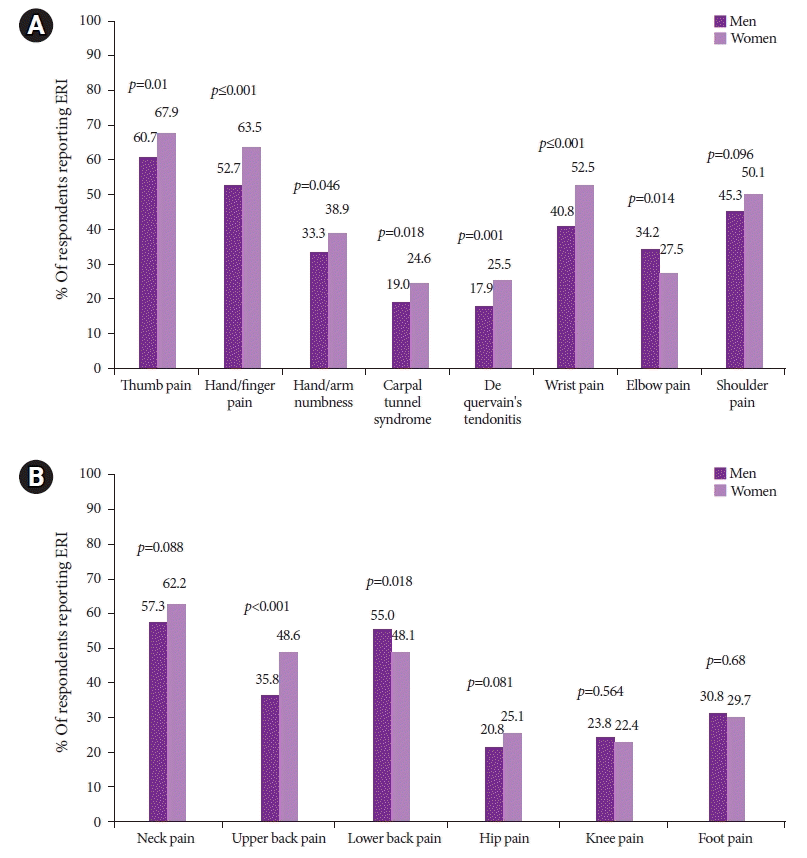 | Fig. 1.(A) Location of self-reported upper extremity endoscopy-related injury (ERI). (B) Location of self-reported back/neck and lower extremity ERI. Adapted from Pawa et al. Am J Gastroenterol 2021;116:530–538, with permission from Wolters Kluwer Health Inc.15
|
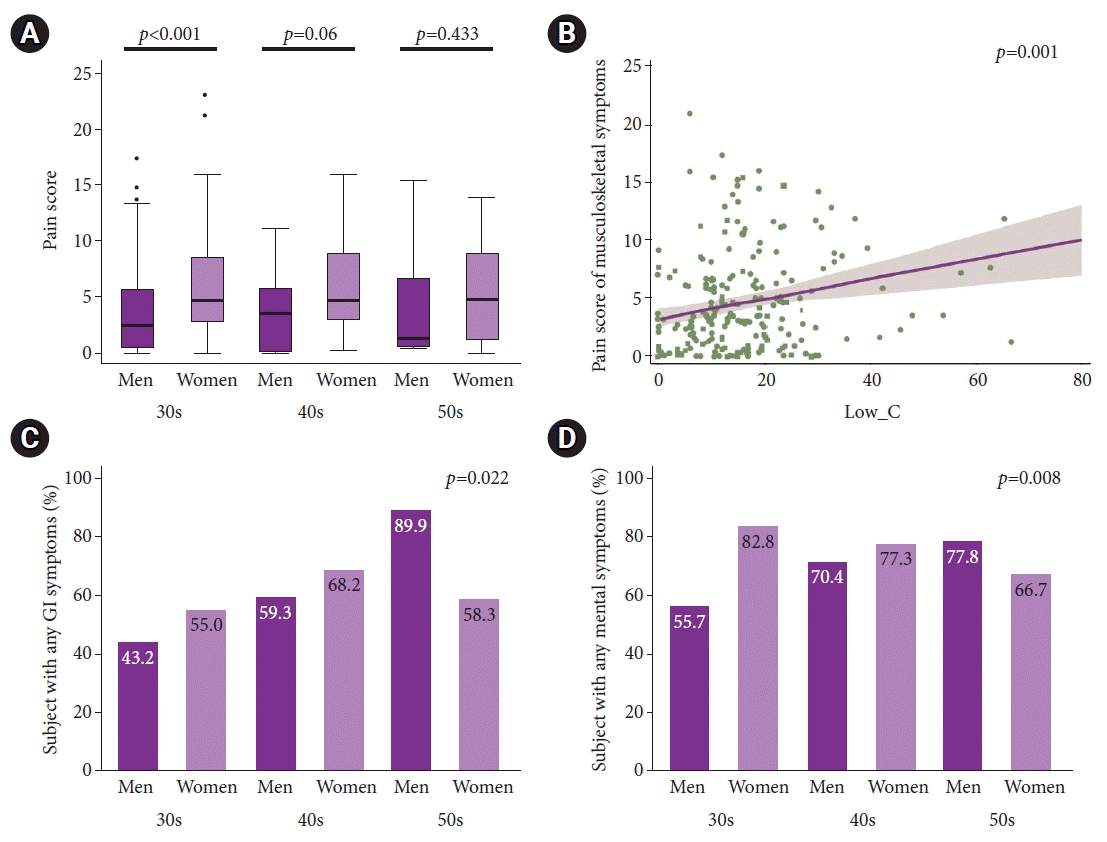 | Fig. 2.Musculoskeletal, gastrointestinal (GI), and mental symptoms depending on age and sex. (A) Musculoskeletal pain score. (B) Correlation between the number of colonoscopy and musculoskeletal pain. (C) GI symptoms. (D) Mental symptoms. Adapted from Jang et al. Dig Dis Sci 2020;65:86–95, with permission from Springer Nature.17
|
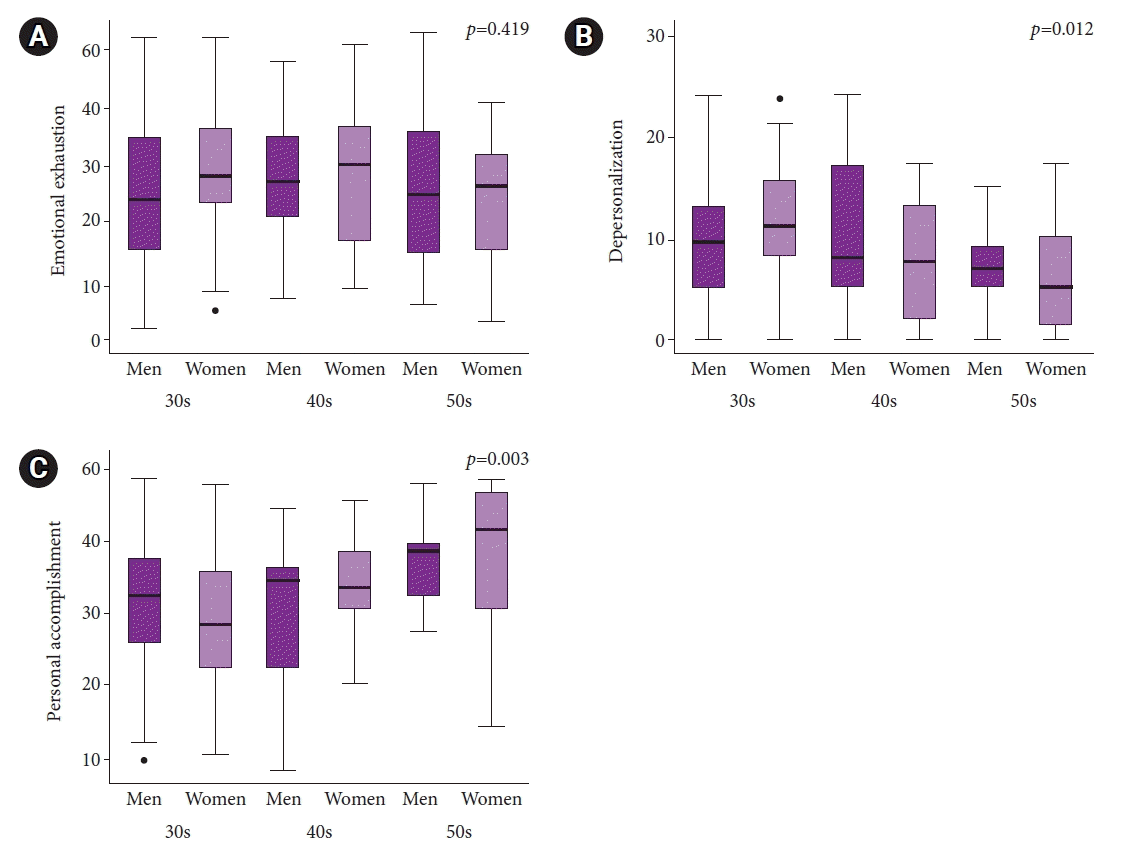 | Fig. 3.Maslach Burnout Inventory scores according to age and sex among Korean gastroenterologists for emotional exhaustion (A), depersonalization (B), and personal accomplishment (C) domains. Adapted from Jang et al. Dig Dis Sci 2020;65:86–95, with permission from Springer Nature.17
|
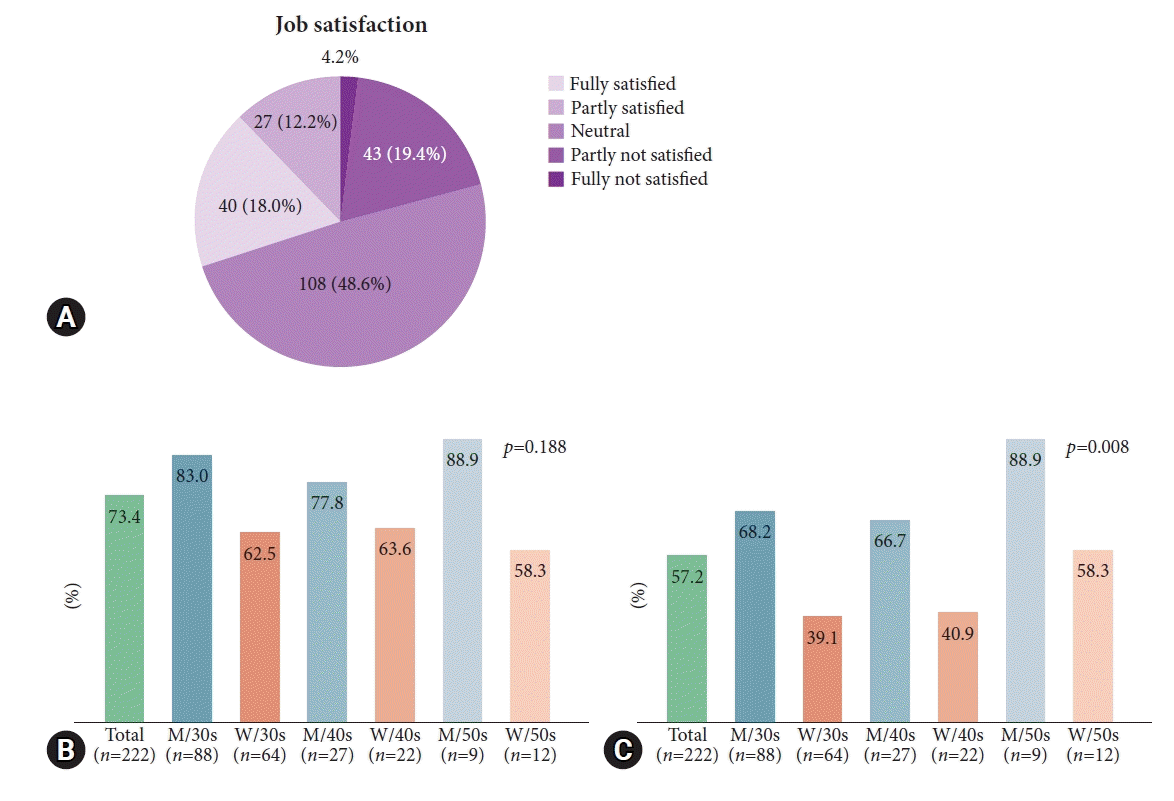 | Fig. 4.Job satisfaction among Korean gastroenterologists and reselection job rates if they had a chance to select their job again. (A) Job satisfaction. (B) Possible reselection rate of the profession of
doctor. (C) Possible reseclection rate of the profession of gastroenterologist. M, man; W, woman. Adapted from Jang et al. Dig Dis Sci 2020;65:86–95, with permission from Springer Nature.17
|
INTERVENTION STRATEGIES FOR THE FEMALE ENDOSCOPISTS’ BURNOUT
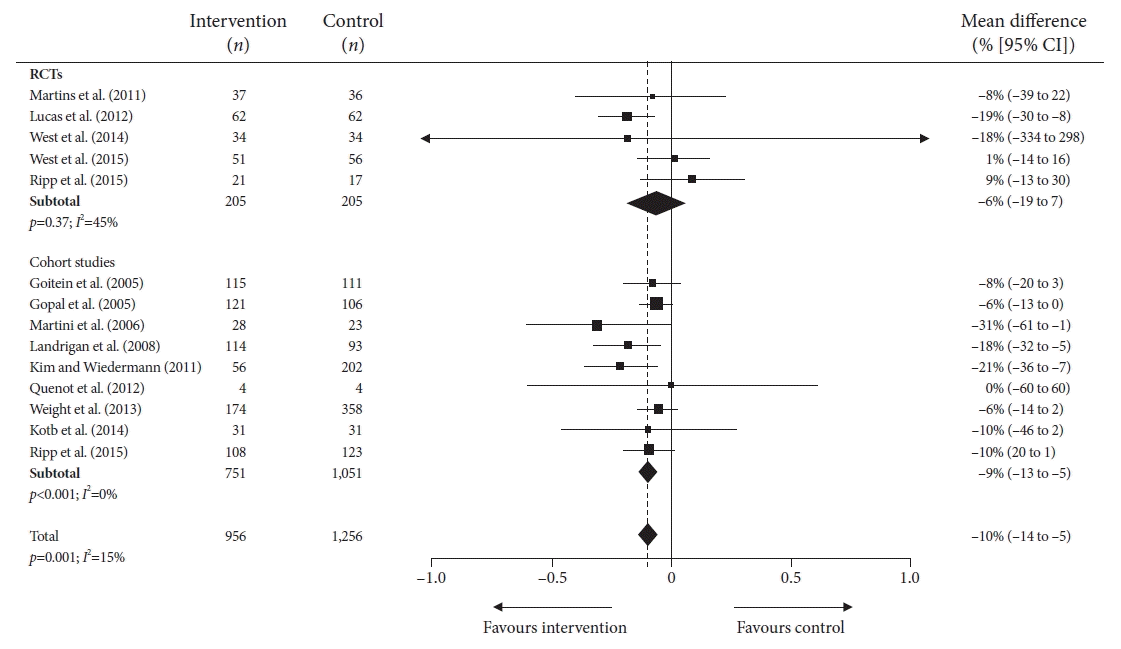 | Fig. 5.Overall burnout. For the five randomized controlled trials and nine cohort studies reporting differences in overall burnout, the pooled mean difference estimate was a significant absolute reduction from 54% to 44% (difference, 10%; 95% confidence interval [CI], 5–14; p<0.001; I2=15%). RCT, randomized controlled therapy. Adapted from West et al. Lancet 2016;388:2272–2281, with permission from Elsevier.18
|




 PDF
PDF Citation
Citation Print
Print



 XML Download
XML Download